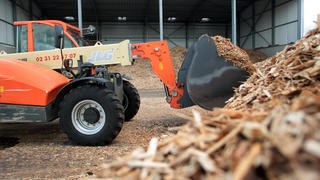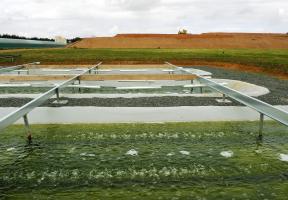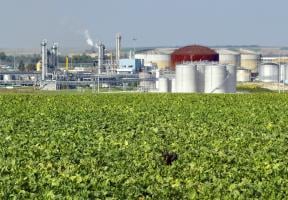Wood: The Energy Source in France's Energy Mix
10 min read
In France, wood is the top source of bioenergy and the number one source, outranking hydropower and coming in well ahead of wind and solar energy. More than 95% of this wood is used to produce , whether in industrial or household settings, while the rest is used to generate . This type of energy is called wood energy.

© KENZO TRIBOUILLARD / AFP - Branches shredded in the forest are transported directly to wood-fired power plants.
Wood, whether in the form of logs, branches, bark, sawdust, sawmill waste or joinery offcuts, is the main source of used to produce energy in France, primarily for heating.
An examination of primary renewable energy production in France reveals that wood energy is the most prevalent renewable (accounting for 40% in 2015, or 9.2 million metric tons of oil equivalent), followed by hydropower (20%), (11%), heat pumps (8%), wind (8%) and solar (3.4%). This well-defined order rarely changes, although hydropower and wood energy production are highly dependent on rainfall and winter temperatures. Overall, based on final energy consumption for any purpose, renewable energies account for around 15% of France's .
Uses of Wood Energy
In all, 76% of wood energy is used for residential heating and the remaining 24% is used in the district heating, commercial and industrial sectors.
The industrial sector is represented by businesses that use heat in their industrial processes as well as by heating plants that power district heating for entire urban neighborhoods, apartment buildings and public facilities in rural communities. According to the French Environment and Energy Management Agency (ADEME), there are more than 5,000 such plants in the district heating sector. These types of facilities are promoted by Fonds Chaleur, a fund overseen by ADEME since 2009 and whose purpose is to contribute to the development of "renewable heat".
Wood is seldom used to generate electricity. Instead, it is generally combined with heat production in plants, which can thereby reduce their energy costs. In one very special case, wood is being used to gradually replace at one of France's largest thermal power plants. Located in Gardanne in the Provence region, the plant was initially designed to run on German .
Outside of its use in energy production, wood can, as is the case for all biomass materials, be processed to extract various substances that fall within the realm of "green chemistry", including pharmaceutical and cosmetic products, resins and cellulose fibers, adhesives and gums, and lactic acid.
The Pros and Cons of Wood Energy
- Wood energy emits low amounts of CO2 – The raw material used, wood, comes from forests that can eventually grow back. The storage of carbon in the wood fibers during tree growth therefore offsets the greenhouse gases that are emitted into the atmosphere from the burning of wood. From a "life cycle" perspective, emissions from the wood industry's entire scope of operations must also be taken into account, including tree harvesting, transportation and processing. ADEME, which has calculated the amount of energy consumed from the moment the raw materials were obtained until the actual production of heat, found that heating using oil, gas and electricity emitted 480 kilograms, 222 kilograms and around 180 kilograms of CO2 per megawatt-hour, respectively, whereas wood heating emitted only 40 kilograms.
- Wood energy is cost-effective – Based on optimal usage in households, the French Renewable Energies Syndicate (SER) estimates that the cost per kilowatt-hour of wood heating is 4 euro cents for logs and 5.82 euro cents for pellets, compared with 7.08 euro cents per kilowatt-hour for fuel oil and 15.55 euro cents for electricity. Wood prices are very stable and are not impacted by global prices because most wood is produced locally.
- Wood energy provides jobs in rural areas – Wood harvesting helps maintain some 50,000 jobs, which are protected from offshoring, and promotes the development of rural areas by providing farmers and foresters with an additional source of income.
Nevertheless, wood energy does have two main drawbacks:
- Wood energy emits fine particles and gases – In theory, the complete combustion of wood produces only CO2 and water. This is indeed the case 99% of the time, but nitrogen oxides (NOx) and fine particles (primarily formed from minerals) may also be emitted. When incomplete combustion occurs, which is often the case, (CO) is emitted, as well as dioxins and furans, volatile organic compounds (VOCs) and unburned solids such as soot, tar and .
- Wood energy causes deforestation – Deforestation diminishes the carbon capturing abilities of forests, decreases and can adversely affect the landscape.
Biomass energy
The term "biomass" encompasses all organic matter. Biomass can be produced by plants, animals, fungi, algae or microorganisms capable of releasing energy, either directly through combustion or after conversion.
Bioenergy from biomass can be produced in the form of heat, electricity, gas or fuel.
Wood and its byproducts (joinery waste, sawdust, etc.) are the main source of biomass, but there are others, such as:
1. Agricultural products, including grains and oilseeds, as well as straw, bagasse from sugarcane and energy plant residue. These products can be converted into biofuels, for example.
2. Byproducts from the paper industry, such as black liquor, and from the food industry, including pulp and seeds.
3. Organic byproducts such as household food waste, urban sewage sludge and agricultural effluents.
These types of organic matter are able to produce heat and
, not to mention various byproducts that can be used for chemical applications.






















